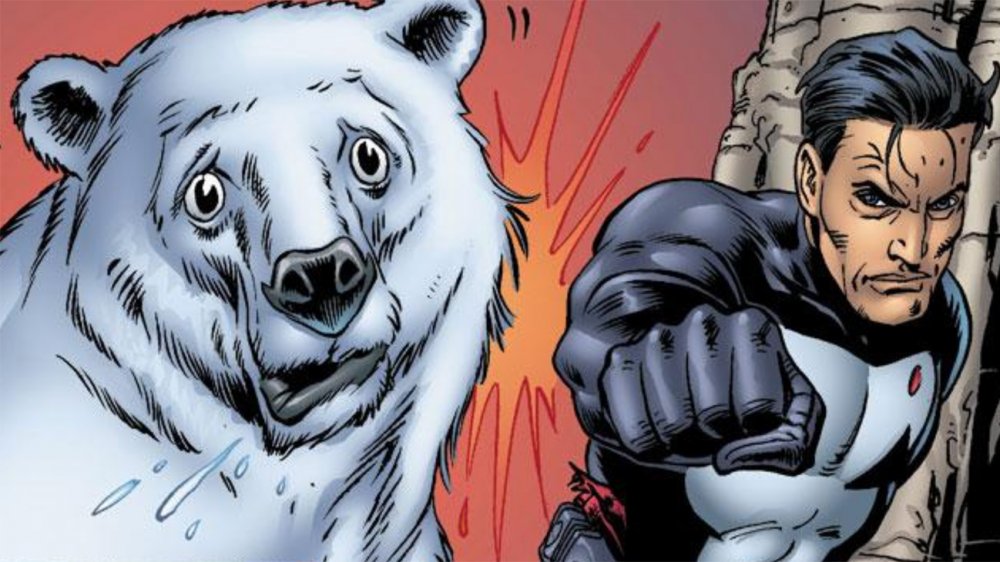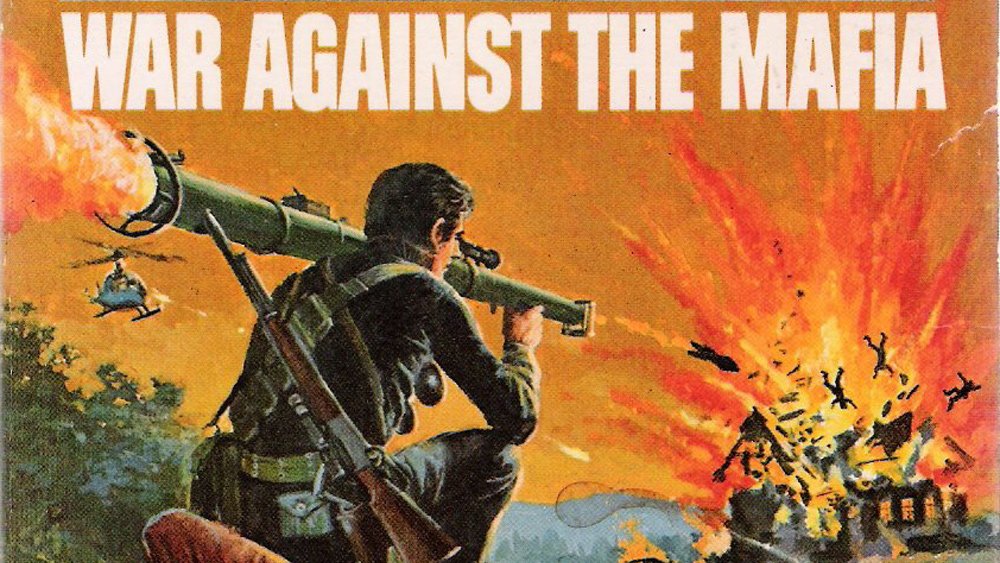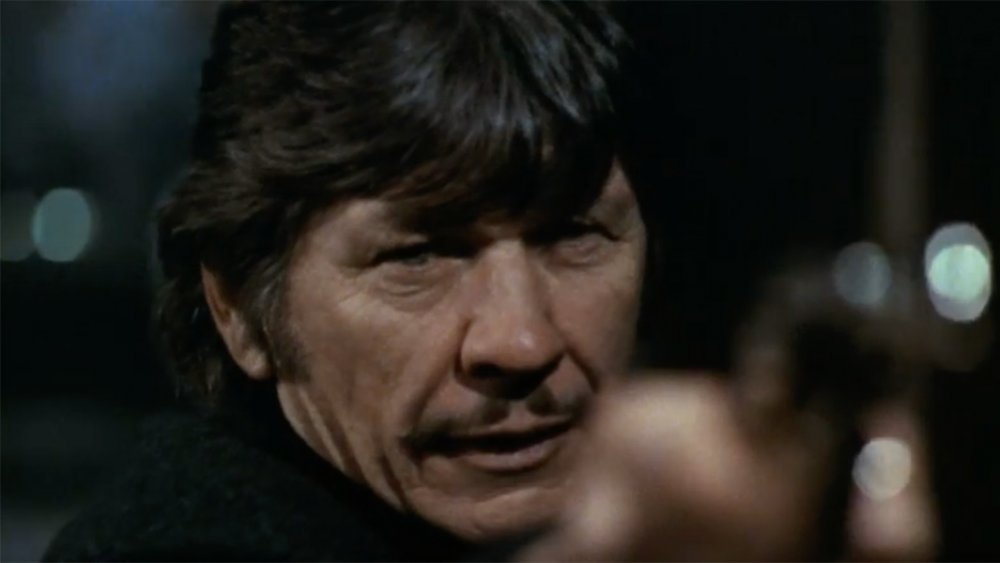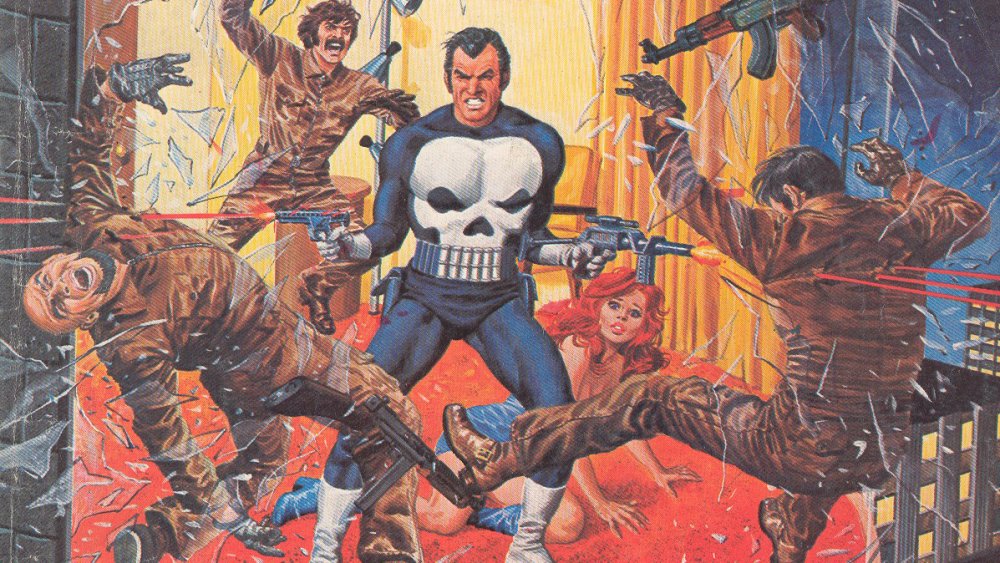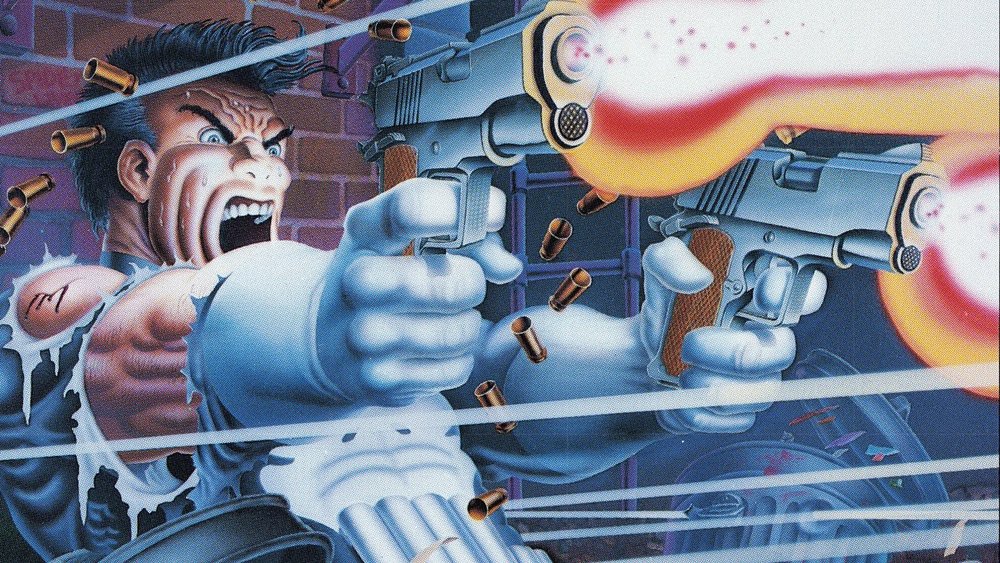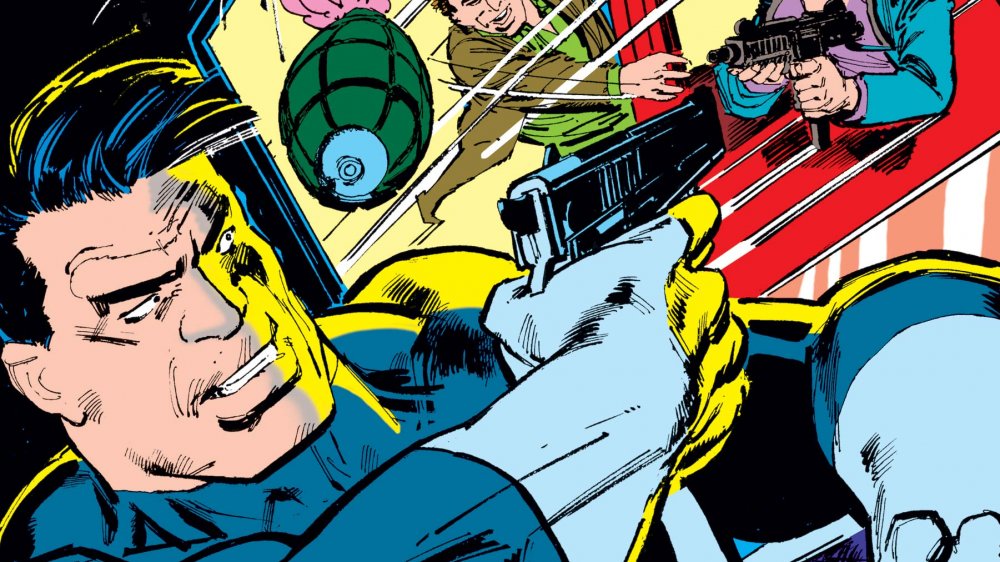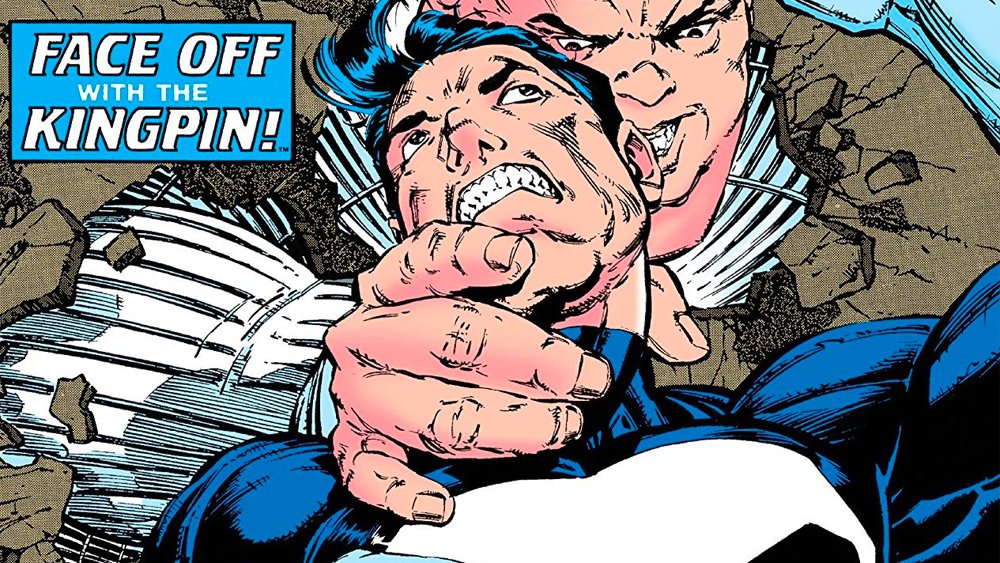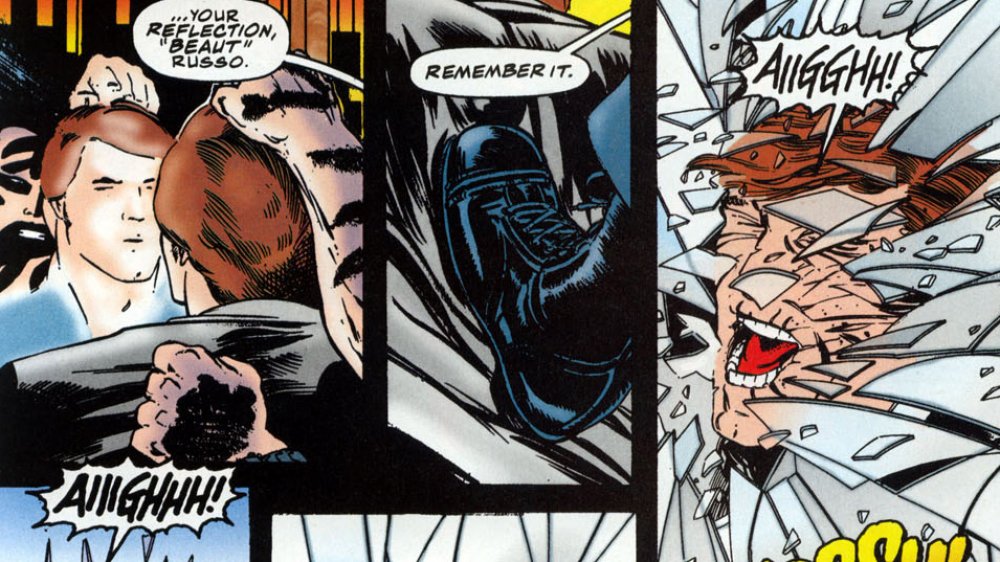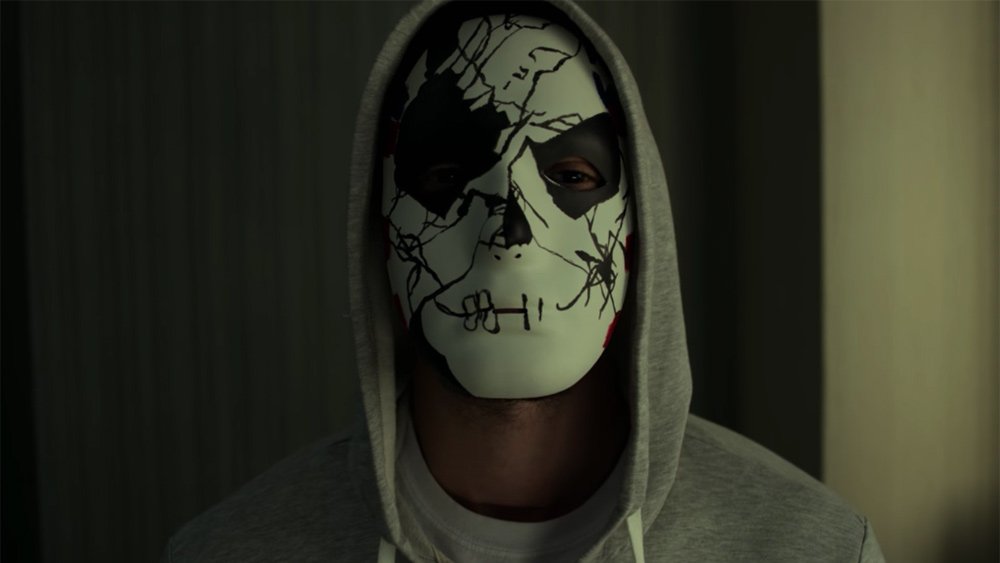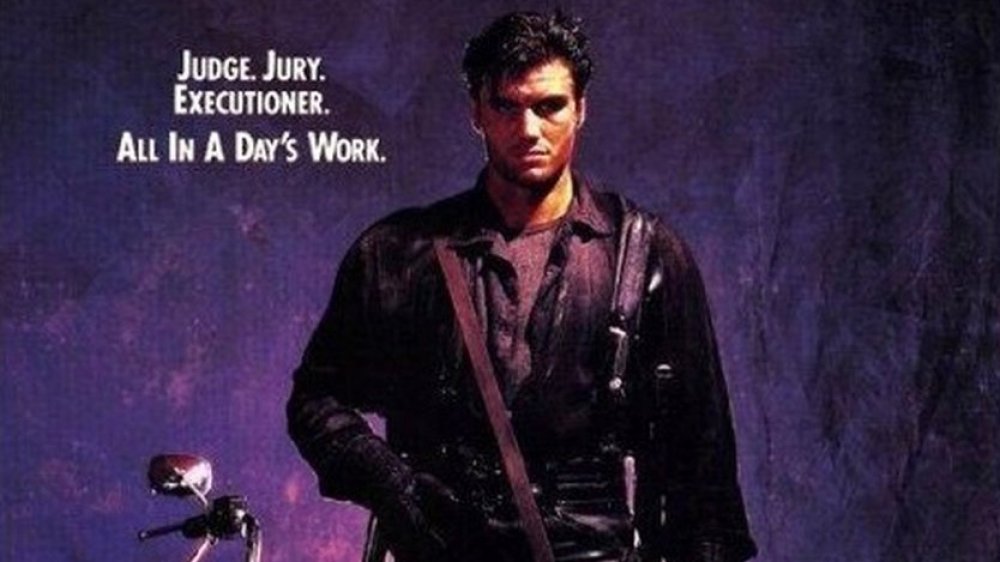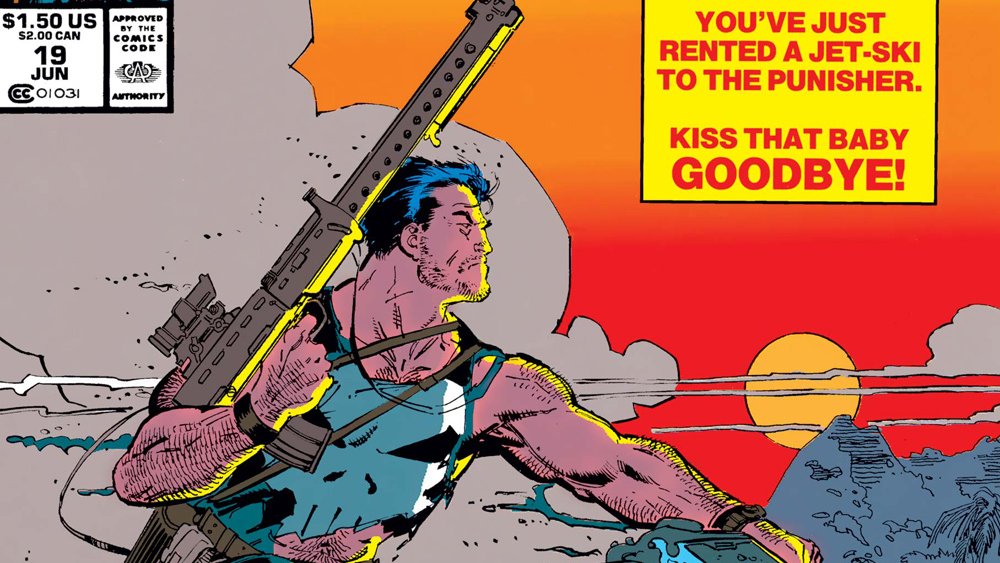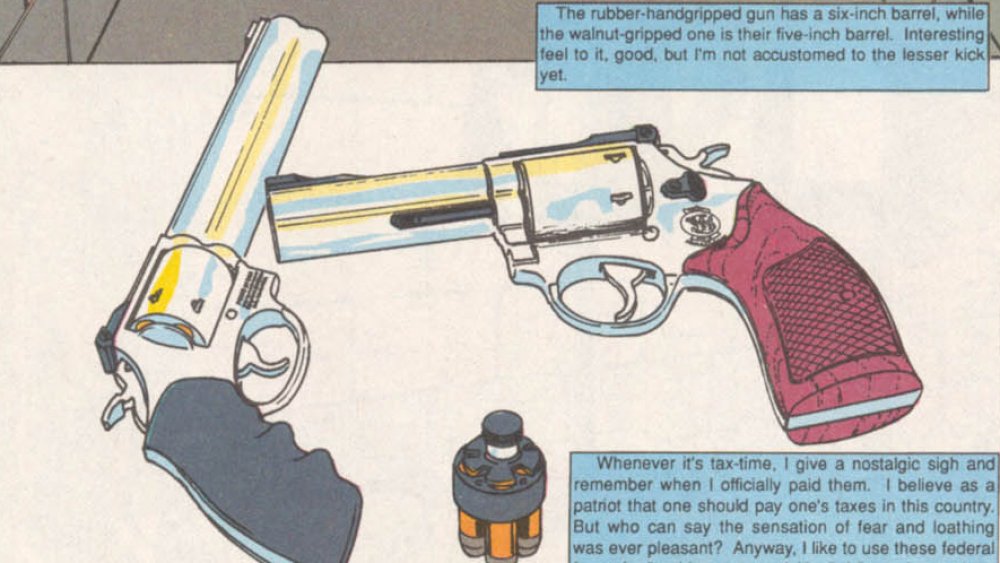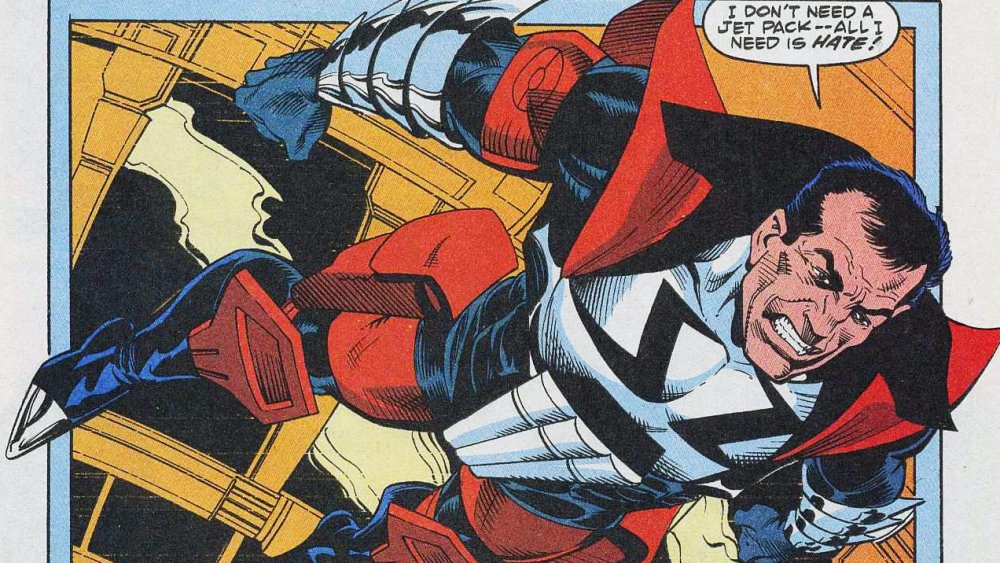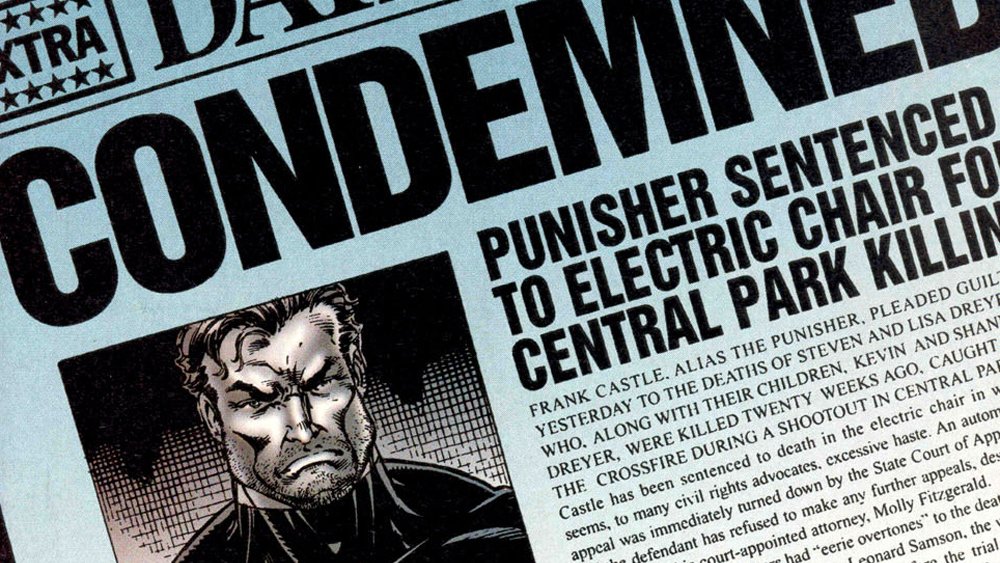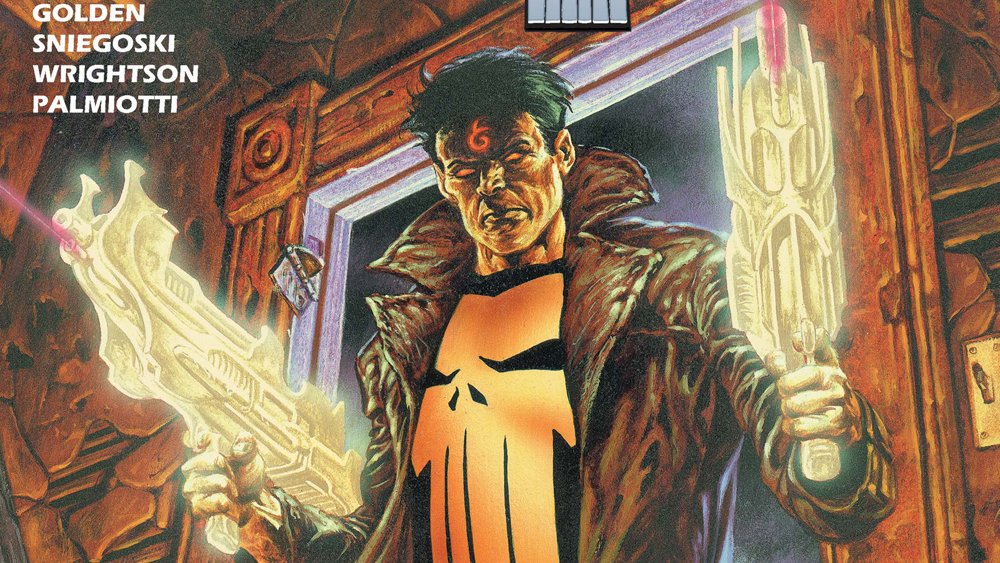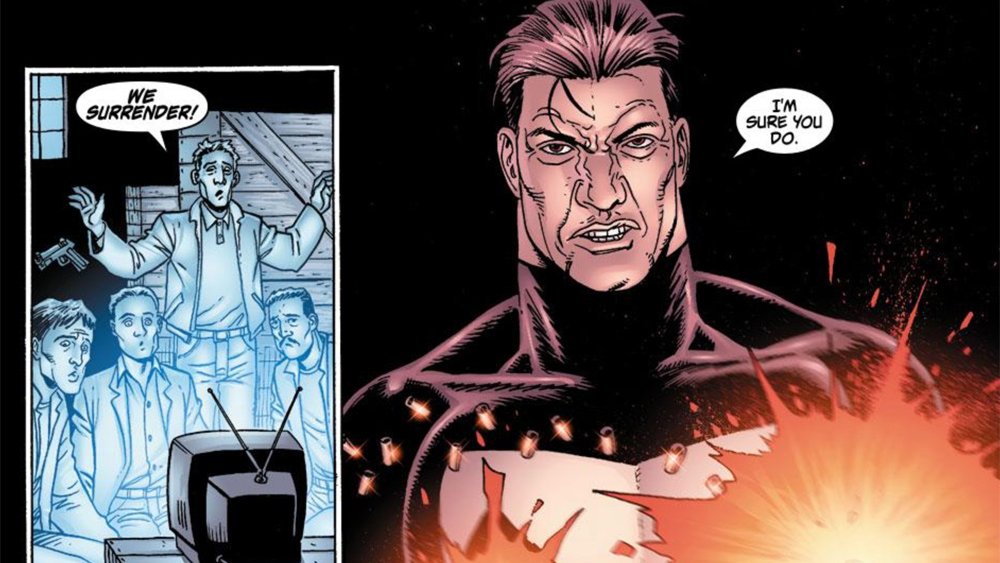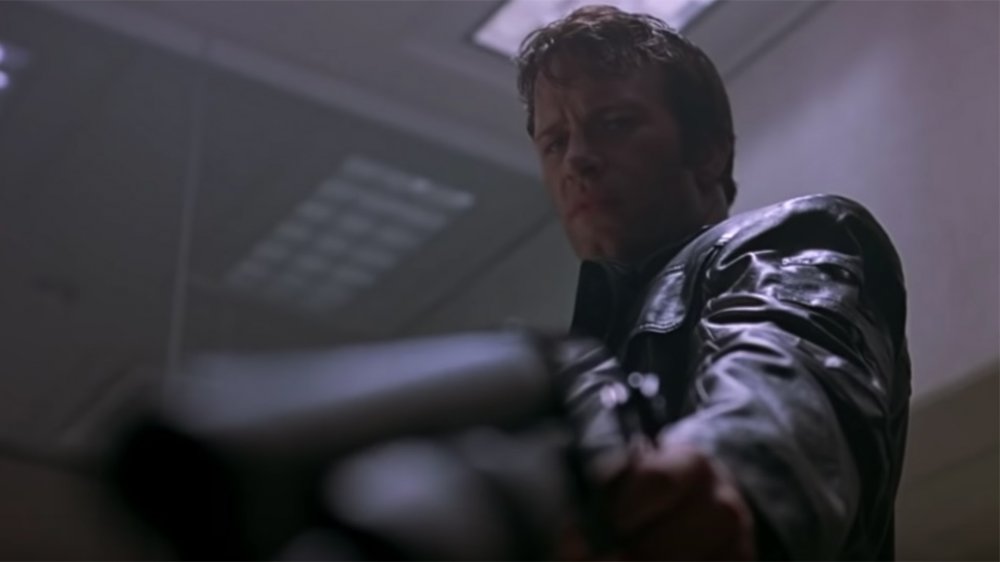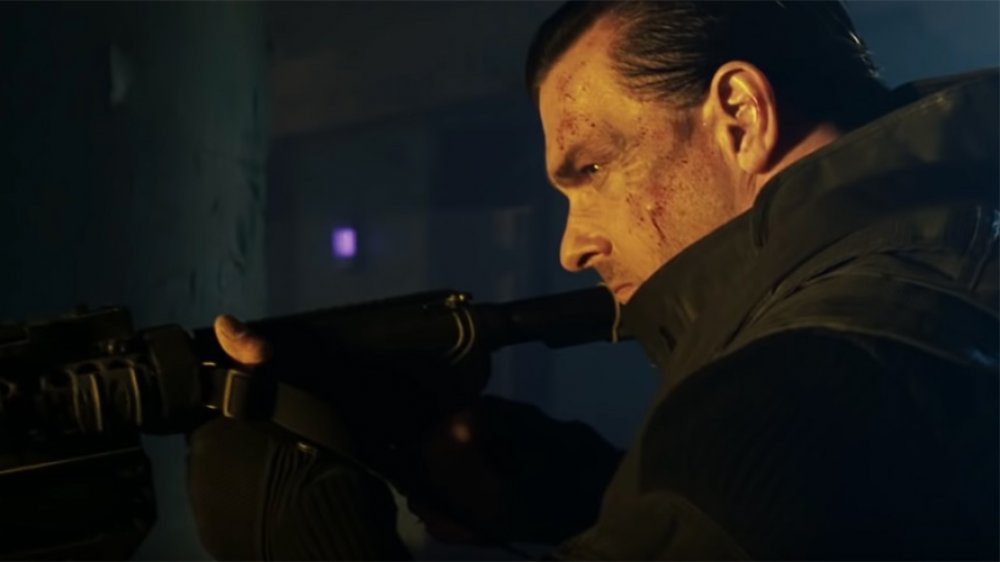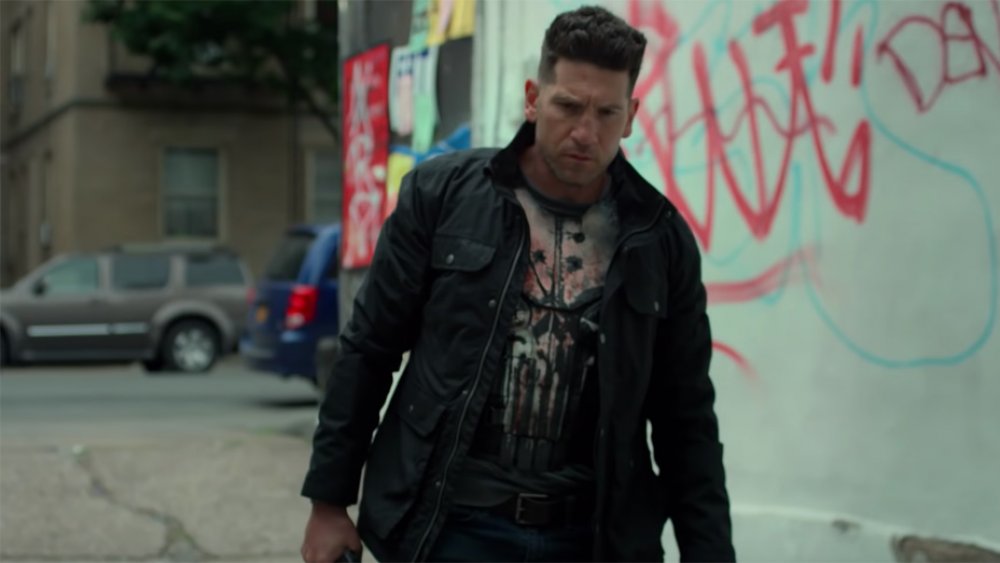The Untold Truth Of The Punisher
Frank Castle is a very different kind of superhero. In fact, it's debatable as to whether he's even a superhero at all. Despite being introduced in the pages of Amazing Spider-Man, headlining multiple Marvel comics, taking on supervillains, and even spending about a month claiming to be Captain America, his brutal one-man war on crime has never been the usual comic book adventure. Instead, he's been called an anti-hero, a vigilante, and a power fantasy that goes far darker than superheroic escapism. There are even some who claim that he should be permanently retired for being as damaging to the real world as he is to his comic book universe, which is not the kind of thing you usually hear about, say, Green Lantern.
But the things that make the Punisher so unique and polarizing go beyond the way that he deals with criminals. From the influences that led to his creation to the strange evolution on the page to his conflicts with the real world, here's the in-depth, untold truth behind the Punisher.
The Executioner
There are very few comic book characters whose creation hasn't been influenced by something else. Even the earliest heroes were riffing on something — a lot of the ideas that found their way into Superman had their origins in Doc Savage and Philip Wylie's Gladiator, and calling those first few Batman stories anything other than ripoffs of The Shadow is being charitable.
The Punisher was no exception. Before Frank Castle hit the comics page in 1974, there was Mack Bolan: The Executioner. Created by Don Pendleton in 1969, The Executioner was a series of pulpy adventure novels that were incredibly successful, with a new installment from Pendleton (and a team of ghostwriters) hitting bookstore shelves every month. All told, there were 453 installments as of 2017 — 22 years after Pendleton's death — with a couple hundred spinoffs to boot.
As for what they were about, well, see if any of this sounds familiar. Mack Bolan was a highly decorated Green Beret whose service in the Vietnam War resulted in 97 confirmed kills and earned him an evocative nickname. Unfortunately, his action as a soldier couldn't keep him from experiencing tragedy on the home front. His family was murdered in a gruesome crime that turned out to be tied to the Mafia, prompting Bolan to go AWOL and launch a one-man war against organized crime. Obviously, that's completely different from the Punisher. Frank was in the Marines, not the Army, and Bolan was from Massachusetts, not New York.
Death Wish
The influence of The Executioner on The Punisher wasn't subtle, nor was it a secret. An early Punisher appearance in 1975 in the black-and-white Marvel Preview actually featured an incredibly in-depth interview with Pendleton himself. The interview never mentions the Punisher — which seems both completely intentional on Marvel's part and also a little bit odd considering that it's printed in a magazine with Frank Castle blowing away bad guys on the cover — but Pendleton's discussion of his character makes the similarities clear. You can see a lot of the groundwork for how the Punisher would work going forward.
They might've been the most direct influence, but Pendleton and Mack Bolan were far from the only ones. Revenge has been a popular theme in literature for eons, from The Iliad to Hamlet and The Count of Monte Cristo, and the changes in popular media in the '60s and '70s embraced that with their own pulpy, violent stories.
The most prominent among them, at least in terms of charting Frank the Tank's literary lineage, was Death Wish. Based on the novel of the same name, the movie followed Paul Kersey (Charles Bronson), a man who — again, see if you recognize any of these subtle similarities — became a murderous vigilante after his wife and daughter were attacked by criminals. Kersey kills 10 people in the first film, which by any normal measure is a whole lot of murders. In Death Wish 3, however — a movie that was made well after the Punisher had attained the height of his popularity amid the changing landscape of action movies — he racks up a kill count of 42 onscreen murders, including using a literal bazooka to blow up one (1) guy.
He's different! He's deadly!
In 1972, Gerry Conway became the second regular writer of The Amazing Spider-Man. It was something of a dream job for Conway, who had been a fan of Marvel since its inception, but it also came with pressure. For one thing, Conway was only 19 when he got the job. For another, the writer he was replacing was Stan Lee, who had been on the book for its first hundred issues, plus a handful more.
To say that Conway's first few years on Spidey were eventful is selling things short. One of his first major stories was "The Night Gwen Stacy Died," in which Peter Parker's longtime love interest was killed by the Green Goblin. Eight issues later, Conway and Ross Andru would change the course of Marvel Comics by introducing the Punisher. The version who appears there is a bit different from how he'd evolve over the next decade, but you can see the groundwork in the original story. Despite being a hired assassin working for supervillain/creepy weirdo the Jackal, he claimed to only kill those who "deserved" it, and was only targeting Spider-Man because he'd been tricked into believing that Spidey was a murderer. He also mentions that he's a former Marine, but now fights "a lonely war."
Originally, the Punisher was conceived as a straight-up villain, which is reflected in Andru's design that includes a massive skull that takes up his entire torso. In the course of writing the issue, however, Conway realized that "he had a moral code I could use to resolve story points." As a result, the Punisher simply walked away at the end of the story, with Spider-Man getting over the whole "attempted murder" thing pretty quickly.
Circle of Blood
While he wouldn't get his own comic for another ten years after his initial appearance, it wasn't long before the Punisher started headlining stories of his own. Mostly, this happened in the pages of magazines like Marvel Preview, which were printed without the approval of the Comics Code Authority, and lent themselves to more violent, adult-oriented tales. While the line of late '70s black-and-white mags included Marvel stalwarts like the Hulk, Dracula, and Conan the Barbarian, that content kept them — and the Punisher's brand of gun-toting adventure — at least a little bit separated from the main line of comics.
All of that changed in January of 1986 and the release of The Punisher #1. It might be surprising that it took that long for Marvel to strike that particular iron, but it also makes a lot of sense. The Comics Code's strict forbiddance of stuff like heroes shooting people in the face had eroded over the years, and Marvel had found quite a bit of success with more violent, "mature" storytelling. Frank Miller's work on Daredevil, both solo (1981 – 1983) and with with artist David Mazzucchelli (1986), and the first Wolverine solo series, with writer Chris Claremont (1982), were massive commercial and critical successes that dove into a darker, more intense side of the Marvel Universe.
Steven Grant and Mike Zeck's four-issue limited series followed right in those footsteps. Titled "Circle of Blood," it picked up with Frank being sent to prison at Ryker's Island, which, as you may know, is a very large building containing nothing but people who hate the Punisher. It followed Frank as he was broken out by the Trust, a clandestine organization that wanted to fund him in his war against crime and spark a gang war that would take out most of Manhattan's criminals. Eventually, they turned on him, but Grant's brisk writing and Zeck's intense, fluid artwork — which would define the look of the character for the next 15 years — set the pattern that other Punisher stories would follow.
Building the Castle
The five-issue miniseries was a success, and 1987 saw the launch of a Punisher series that would run for over a hundred issues and cement Frank Castle as one of Marvel's top characters.
Like Circle of Blood before it, the Punisher ongoing series — launched with artist Klaus Janson and writer Mike Baron, who would remain on the title with various artists for the first 60 issues — was one step removed from the rest of the superheroes of the Marvel Universe. It was still definitely a Marvel title — Frank dealt with a secret ninja cult and fought Doctor Doom with a jetpack in #28, which is about as Marvel Universe as it gets — but the focus was rarely on supervillains. Instead, much like it had in the beginning, the Punisher's solo adventures drew their influences from outside comics.
That's a nice way of saying that Mike Baron spent a few years basically rewriting the action movie aisle of a Blockbuster as 22-page comics. The most egregious example comes pretty early on. In Punisher #14, Frank goes undercover as a substitute teacher to root out a drug dealing operation at a high school, an adventure that bears some striking similarities to Class of 1984, a film that's basically just "what if the guy from Death Wish was a high school teacher?" To Baron's credit, though, the story where Frank goes undercover with a biker gang to topple their meth empire actually predates the release of Stone Cold, a cinematic flop starring ex-football player Brian Bosworth with the exact same plot, by over a year.
Hard targets
Frank Castle kills his enemies. It's the thing that sets him apart from the other characters in the Marvel Universe, and to a larger extent, superheroes as a whole. In a genre that's largely defined by characters who have a personal code against taking their foes' lives, Frank is the one who thoroughly and methodically puts a permanent end to all of his opponents. There is, however, a problem with that, at least from a storytelling standpoint: if you kill your enemies, they can never be developed into compelling nemeses. If you get right down to it, that's the real world reason that Batman doesn't kill the Joker. He's just too popular to go away forever.
That extends into another problem, in that it limits the scope of Frank's enemies to characters he can actually kill. The Punisher's arch-enemy for the first year of his solo title was the Kingpin, and that story never resolves for the simple reason that it can't. Not only does he "belong" to another hero — if anyone's got dibs on fighting Wilson Fisk, Frank's third in line behind Daredevil and Spider-Man — The Kingpin is too big a character to be killed off buy a guy who primarily fights regular human criminals. Put them together and the end result is that the Punisher, by his very nature, doesn't have many villains who survive their first appearances.
Cut to the feeling
There are a few exceptions to the Punisher's tendency to kill off the bad guys, and the biggest is Jigsaw. After originally appearing in Amazing Spider-Man #162 (with a shadowy cameo in the previous issue), Jigsaw would return as a bullet in Frank's side for years, proving himself to be someone who just would not die, no matter how much punishment he was put through.
Jigsaw was built around a pretty simple concept: in his early days as a vigilante, Frank chucked a "two-pit punk" named Billy Russo headfirst through a plate glass window. Billy's formerly handsome face was shredded by the shards of glass, and after it was stitched up into a form that closely resembled a jigsaw puzzle, he was out for revenge. The thing is, none of that really happens in his first appearance — possibly because it was a little too violent for 1976. Instead, when Jigsaw first appears, all that stuff is backstory, with the understanding that Frank has been around for a while doing terrible things to criminals. Along the same lines, Frank mentions in Punisher #4 (1987) that he has a "career lifetime total" of 665 kills. These days, that number is significantly higher.
As for Jigsaw, there's something of a recurring gag about how he'll get his face fixed, only to have it messed up again by the end of the story. The strangest example of this might be the time that his face was healed by a mystically powerful villain named Lucifer, who claimed to be (and might've actually been) the actual Devil himself. That lasted about 15 pages before Frank repeatedly rammed Jigsaw's face into a cactus.
Jigsaw hits Netflix
As the closest thing Frank has to a long-term arch-nemesis in the comics, it's not surprising that Jigsaw has made it into most adaptations of the Punisher, including the Netflix show. This version of the character, played by Ben Barnes, had a very different origin. Rather than just being some two-bit mobster, Billy Russo was an old friend of Frank's that he'd served alongside in the Marines — which also made him one of the soldiers who'd murdered an innocent man who was framed for being a terrorist. To keep his secret, Russo tried to kill Frank, but you already know how well that works out for the bad guys. At the end of season 1, Frank repeatedly smashed Billy's face into a mirror.
Considering how violent the Netflix shows can get, it's a bit surprising that Billy's scars aren't quite as grotesque as his comic book counterpart's. Instead, Netflix's Jigsaw developed a fascination with the masks he wore while recovering from his injuries, decorating them to be creepy, disfigured skulls due to his nightmares about Frank. He did share the original's desire for revenge, though, and his success rate. After Frank took out Jigsaw's entire crew of henchmen, the Punisher displayed no emotion whatsoever as he shot his former best friend. It's worth noting that Jigsaw was trying to apologize at the time, which worked about as well as anything else — which is to say, it didn't.
Taking aim at Hollywood
By the end of the '80s, the Punisher was well on his way to becoming one of the most popular characters in Marvel's catalogue of heroes. He also had one advantage that Spider-Man and the X-Men didn't: he didn't have the kind of superpowers that would require a massive special effects budget to bring to film. Say what you will about the action movies that crowded theaters in that decade, "guy with gun shoots bad guys who also have guns" was a story they were more than capable of telling.
As a result, the 1989 Punisher movie, in which Dolph Lundgren starred as Frank Castle, probably seemed like a safe bet for low-budget success. It was not. The film was never theatrically released in America and wouldn't hit home video until 1991, and the few diehard Punisher fans who did see it would write into the comic with letters about how cheesy it was, and how it failed to capture what made the character so compelling. Also, the yakuza villains are exactly the kind of one-dimensional stereotypes you'd expect from a low-budget action movie in the '80s.
Looking back from 30 years later, however, The Punisher '89 has its share of flaws, but it's also a pretty faithful adaptation. The plot is lifted from the first year of Punisher solo comics, where Frank's war against the mob has caused them to seek an uneasy alliance with the yakuza. The origin was changed to make Frank a cop rather than a soldier, distancing him from Vietnam, but that's also a tactic that different comic book versions of the character have uses. Also, as far as being cheesy goes? The Punisher comic that was on shelves the month before the movie's U.S. release featured a villain who decapitated people with a yo-yo.
Mr. Popularity
It's no exaggeration to say that by the early '90s, the Punisher was one of Marvel's most popular characters. If you need proof, look no further than the sheer amount of comics about the character that were being published. In 1988, Punisher was joined by Punisher War Journal, with both titles shifting to a twice-a-month schedule every summer so there was a new Punisher on the stands every week. In 1992, they were joined by Punisher War Zone, plus Punisher 2099. (We'll get back to that.)
For comparison, while the Punisher was starring in three titles every month, characters like Captain America, Iron Man, and Thor all had... one apiece. The Avengers had their regular title and Avengers West Coast. The only other characters on or above Frank's level at the time were Spider-Man, with four, and the all-consuming, unstoppable steamroller that was the X-Men, which topped out somewhere around nine or ten, if you count everything that had a reasonable chance of Wolverine showing up.
On top of that, there were dozens of miniseries, one-shots, and specials, including Punisher: Year One (a flashback where readers finally got to see Frank put Jigsaw's face through the glass), Punisher: G-Force (a prestige-format one-shot where Frank hijacked a space shuttle to kill a dude in orbit), and several Punisher: Back To School specials, which exist despite having the most ill-advised concept in history. All told, there were around 26 different Punisher series or one-shots published between 1990 and 1995, clocking in with a total of 343 issues and three book-length original graphic novels. For comparison, that's how many issues of Amazing Spider-Man were published from 1963 to 1991.
His thoughts! His feelings! His weapons!
The strangest one by far, however, was Punisher Armory, a ten-issue series written and drawn by Eliot R. Brown in 1990. Punisher Armory's first issue promised to reveal "His thoughts! His feelings! His weapons!", and did exactly that.
There was no plot, just full-page drawings of guns and other assorted weapons, captioned with highly detailed reviews written from Frank Castle's point of view. Please note that almost all of these were real guns, and said reviews often contained Frank's endorsements for real-life gun manufacturers. If you wanted to pick up Betty & Veronica, a pack of X-Men trading cards, and a recommendation for which company was making the best hollow point ammunition but you didn't want to go to two different stores, then 1990 was a great time to be alive.
The weirdest thing about Punisher Armory — well, one thing that's slightly weirder than its existence as a whole — comes when you try to figure out why it exists in the world of the comics themselves. If these are Frank's thoughts about his weapons, then who is he writing them down for? Is he just trying to remind himself about which guns are good in case he gets concussed in a fight with Daredevil and forgets? Is it like a shopping list, or one of those recipe websites that'll make you read a novel about someone's childhood bread memories before they tell you how much flour you need?
Punisher 2099
Only slightly less bizarre than Punisher Armory was the franchise's fourth ongoing series, and the only one that didn't star Frank Castle: Punisher 2099. Launched in 1992, the first wave of 2099 books was focused on cyberpunk versions of Spider-Man, Doctor Doom, and the Punisher, with a new book called Ravage 2099 that marked Stan Lee's first brand-new creation (along with artist Paul Ryan) in years. If you haven't heard of him, well, there's a reason for that.
Punisher 2099, on the other hand, is worth your time if you ever find it in a dollar bin somewhere. Jake Gallows essentially had the same origin as Frank — family murdered by bad guys, big jacket with a skull on it, etc. — but when he found the original Punisher's old War Journal, he decided to take up his one-man war. If Frank was an anti-hero you could understand, Jake was a full-on fascist with a secret prison under his house where he kept bad guys until he executed them by disintegrating them one cell at a time. He would later become the director of S.H.I.E.L.D. after Doctor Doom took over the world.
Punisher 2099 was probably the closest that American comics have ever come to capturing the "future-shock" weirdness of Judge Dredd, and for good reason. The series was written by Dredd co-creator Pat Mills and Tony Skinner, with art by Tom Morgan. As a result, it was a wildly over-the-top satire with a character so unhinged that he made Frank Castle seem just almost reasonable by comparison. While Frank wasn't above the occasional grim one-liner, Jake told a therapist that his age was "thirty six... caliber" and that his address was "on the edge," and starred in an infamous scene where he jumped out of an aircraft, claiming "I don't need a jetpack — all I need is hate!"
Over the edge (and off a cliff)
By 1995, the age of Frank holding down three monthly titles and flooding the market with spinoffs were over, but to be fair, it wasn't just him. After the massive speculator-driven boom in the early '90s that had seen comics like X-Men #1 selling in the millions, the comics industry nearly collapsed, with a contraction that saw Marvel declaring bankruptcy in 1996. This led the company to sell off the movie rights to popular characters like Spider-Man and the X-Men, leaving them with the ones nobody was really interested in. You know, Iron Man, the Avengers, those guys.
Anyway, after Punisher, War Journal, and War Zone got the axe, Frank was caught up in a crossover called Over the Edge, which, among other things, saw him having a mental breakdown and killing Nick Fury. Fury got better, but Frank also believed that he'd killed an innocent family in Central Park, much like his own family had been murdered. That led him to finally turn himself in and plead guilty for what we can only assume were several thousand murders. He was sentenced to die via electric chair, only finding out seconds before they threw the switch that the family had been killed by Bullseye, who framed Frank so convincingly that he bought it himself.
It will not surprise you to find that Frank's execution was a hoax. Instead, he was broken out by a crime lord who wanted the Punisher to take over his empire. "Punisher joins the mob" was an intriguing hook, but the relaunched Punisher only lasted ten issues.
Fallen angel
In the late '90s, Marvel was clawing its way back from bankruptcy with the time-honored strategy of throwing whatever they could at the wall and seeing what stuck. 1996 and 1997, for example, saw the company rebooting every major franchise outside of Spider-Man and the X-Men on their own Earth in books by Rob Liefeld and Jim Lee, two big-name artists who had left Marvel to found Image Comics with five other creators a few years earlier. Unfortunately for Marvel, this Heroes Reborn saga wasn't quite the blockbuster hit they were hoping for, and isn't remembered fondly by the fans today.
In 1998, however, the tide began to turn. That year saw the creation of the Marvel Knights imprint under artist and editor Joe Quesada, who handpicked creative teams with longtime collaborator Jimmy Palmiotti. The basic idea was to put the spotlight on "street-level" Marvel characters with a grittier direction that would hopefully propel them to stardom, and it worked — so well, in fact, that Quesada wound up becoming Marvel's Editor-in-Chief two years later and Chief Creative Officer in 2010, and is still with the company today. Looking at the four titles that launched the line, it's easy to see why.
Christopher Priest and Mark Texiera's Black Panther redefined the character, introducing lasting concepts like the Dora Milaje and blending the Panther's cooler-than-Bond world-traveling royal Avenger status with street-level action. Paul Jenkins and Jae Lee's Inhumans was the most well-regarded run on those characters since their creation, and has kept that status in the decades since. The flagship book, Daredevil, paired Quesada with writer and filmmaker Kevin Smith, sparking a trend of recruiting from Hollywood that continues.
And then there was Punisher by Christopher Golden, Tom Sniegoski, and the legendary Bernie Wrightson, which is commonly regarded as the low point in the character's long history. The one thing you have to give to them is that after hundreds of issues of lethal action and gun reviews, doing something different probably made sense. The concept they came up with, however, was a bit too far afield: after killing himself off-panel, Frank was resurrected as a ghost and recruited by angels to hunt down demons, using magic machine guns that he pulled out of his magic trenchcoat. The twist was that his celestial recruitment officer had actually been his family's guardian angel, who had been asleep on the job the day they were murdered in Central Park. Despite fantastic art from Wrightson, the book was a flop, and a second attempt at "Angel Punisher" that guest-starred Wolverine didn't improve things.
Ennis and Dillon
Two years after the failed experiment of Angel Punisher, the Marvel Knights line took another shot at Frank, and this time, it worked so well that it would become the definitive take on the character. Fresh from their massively successful Preacher at DC's Vertigo imprint, writer Garth Ennis and artist Steve Dillon took a back-to-basics approach of pitting Frank against an over-the-top caricature of the mob.
Dillon and Ennis —who had previously written a one-shot called Punisher Kills the Marvel Universe, which is exactly what it sounds like — brought Punisher the same blend of ultraviolence, grim humor, and surprisingly deep character work that made Preacher a hit. It produced what was unquestionably the best Punisher run of all time up to that point, influencing virtually every interpretation of the character across all media for the next two decades. Ennis would wind up sticking around as the character's primary writer for the next eight years, with a few scattered stories since. In that time, he oversaw the Punisher's transition from the Marvel Knights line to the flagship of Marvel MAX, the adults-only "Mature Readers" imprint that would also give the world Jessica Jones.
The worst you could say about his run is that it eventually fell into a regular formula. The good news is that Ennis spent the first half of the story making the bad guys so reprehensible that readers wanted to see them die, and then the second half having Frank carry out those desires in wildly violent ways. He also separated Frank and his bloody adventures from the rest of the Marvel Universe. While Marvel Knights had been more of a gray area, the Punisher of the MAX years just did not coexist with characters like Spider-Man and Captain America. Eventually, he'd return to the fold, and the pendulum would swing in a much weirder direction.
See Jane Punish
Propelled by his renewed success in comics, the Punisher would hit the screen once again in 2004, starring Thomas Jane as Frank Castle and John Travolta as the villainous mob boss Howard Saint. This time, the film was influenced by the Ennis/Dillon run, bringing in characters like the Russian, a nearly indestructible assassin played by wrestler Kevin Nash. Unfortunately, in terms of quality, Punisher 2004 is roughly equal to Punisher '89.
While it has a little of the flavor of the comics, the movie gilded the lily with some weird choices that dragged it down. A lot of things that didn't need explaining were given detailed origins, like the Punisher inheriting special guns from his father, and getting his skull logo from a t-shirt his son bought because it scared him. Frank was also an undercover FBI agent, making his family's death a revenge killing rather than the random violence of the original. Perhaps strangest, the setting was moved from New York to Tampa — which, if you haven't been to both, creates a substantial tonal difference.
Despite the movie's flaws, Jane is a solid choice, and clearly developed a connection to the character. He voiced the Punisher in a video game, and pulled out of a sequel because he didn't believe in the script. In 2012, he even made a ten-minute "fan-film" called Dirty Laundry where he reprised the role. The short is bloody to an almost Sam Raimi-esque extreme, building to an action scene where Frank beats half a dozen gang members to death with a bottle of Jack Daniels, and was pretty well-received. Even Jon Bernthal, who would go on to play the Punisher on Netflix, was a big fan.
Punisher: War Zone
A third Punisher film, Punisher: War Zone, was released in 2008 from Academy Award-nominated director and former world karate champion Lexi Alexander, starring Ray Stevenson as Frank Castle. This time, the movie stuck a little more faithfully to the comics, pitting the Punisher against Jigsaw, and bringing in Microchip as Frank's sidekick. Unfortunately, there were also some pretty weird choices, notably in giving Jigsaw a brother, a cannibal named Loony Bin Jim, adding what was essentially just Jigsaw-Plus to the movie instead of just focusing on Frank's most enduring enemy. Still, the movie has a distinct visual style that's similar to what Suicide Squad would be doing a decade later, and the scene where a parkour assassin is blown up with a bazooka in mid-backflip is as close to Ennis' dark humor as the screen has ever seen.
It's worth noting that in an interview with the How Did This Get Made podcast, Alexander talked about how she wasn't a comic book fan and was initially reluctant to take the job. She agreed because women rarely get the opportunities to direct action franchises in general, let alone superhero films. After accepting, she familiarized herself with the character by not just going to the source material, but to fans, contacting people who ran Punisher fan sites. Also notable? Stevenson would go on to stick with Marvel, appearing in the Thor films as Volstagg, but also reprising the role of Punisher in the most unlikely place: The Super Hero Squad Show, a cartoon tie-in to a line of toys for three-year-olds. In his appearance, the Punisher gives the "Squaddies" a ride in his Battle Van, muttering about how his intense hatred of criminals ruining society is comparable to his hatred of broccoli.
Punishflix
The Punisher and Daredevil have been linked in comics for years. They're frequently depicted as ideological opposites, and one of Ennis and Dillon's most memorable issues involved Frank "explaining" his methods by chaining Daredevil up and forcing him to choose between shooting Frank or letting him kill a murderer.
As a result, it wasn't surprising when Netflix's lineup of Marvel series expanded to include the Punisher, who first appeared in Daredevil's second season before being spun off into his own show. Frank Castle was played by Jon Bernthal, who, in addition to being well-known to genre audiences for his role on The Walking Dead, essentially looks like a Steve Dillon drawing stepped off the page and became a real boy. Despite a fairly positive reception, the show was canceled — along with all the other Netflix Marvel shows — in 2019, in advance of the launch of Disney+.
An interesting aspect to this series goes beyond the confines of the screen. Bernthal's performance as the Punisher coincided with the rise of the Punisher's iconography being used — usually on bootleg merchandise without Marvel's approval — by police officers and alt-right nationalists. Needless to say, the idea left a lot of people uncomfortable, and led Gerry Conway to say that "In a way, it's as offensive as putting a Confederate flag on a government building." Bernthal had a different take on the idea of military men taking up the symbol of a veteran that he called "tortured" by "an unbelievable world of darkness and loss," but had a much more blunt (and unsafe-for-work) response to its use by nationalist groups.
